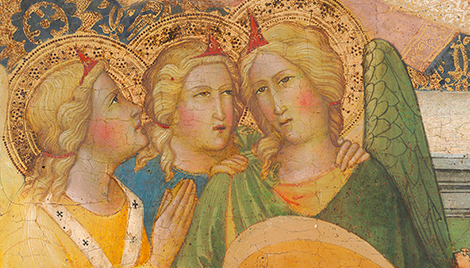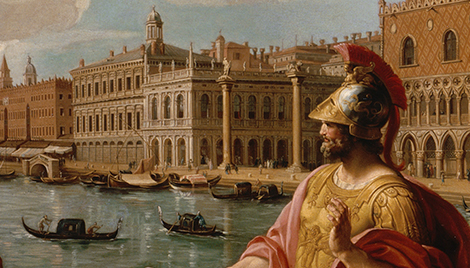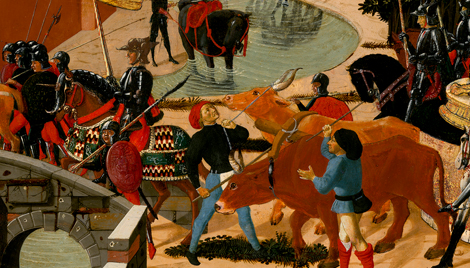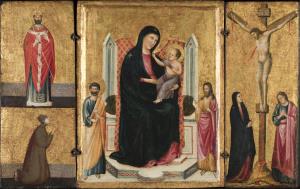Madonna and Child with Saints and the Crucifixion (Triptych)
Madonna and Child with Saints and the Crucifixion (Triptych)
- Artist
- Follower of Duccio di Buoninsegna
- Artist Dates
- c. 1250/1255-1318/1319
- Artist Nationality
- Italian
- Title
- Madonna and Child with Saints and the Crucifixion (Triptych)
- Date
- c. 1300-25
- Medium
- tempera on panel
- Dimensions
- 26.4 x 42.5 cm (10-3/8 x 16-3/4 in)
- K Number
- K1289
- Repository
- Memphis Brooks Museum of Art
- Accession Number
- 61.2
- Notes
Provenance
Paolo Paolini, Rome; (his sale, American Art Galleries, New York, 10-11 December 1924, no. 91, as Duccio); [1] E. L. Craven. Mortimer L. Schiff [1877-1931], New York; (his estate sale, Christie's, London, 24 June 1938, no. 83, as Sienese School); bought by (Volterra). [1] (Count Alessandro Contini Bonacossi [1878-1955], Rome-Florence); sold to Samuel H. Kress [1863-1955] on 1 September 1939; gift to the National Gallery of Art in 1943; deaccessioned in 1952 and returned to the Samuel H. Kress Foundation; gift 1961 to Memphis Brooks Museum of Art, no. MBMA 61.200. [1] Buyer per annotated auctioneer catalogue, Christie's Archive, London.
Catalogue Entry
Follower of Duccio di Buoninsegna
Madonna and Child with Saints and the Crucifixion (Triptych)
K1289
Memphis, Tenn., Brooks Memorial Art Gallery (61.200), since 1960. Wood. 10 3/8 x 16 3/4 in. (26.4 x 42.5 cm.). Inscribed on the cross, above Christ's head: IC -XC (Jesus Christ). Good condition except for some abrasion. This small portable triptych, painted probably in the first quarter of the fourteenth century, is perhaps best classified as Sienese, although it exhibits Florentine traits also, especially in the frontal figures of saints.(1) The main influence is that of Duccio. But the painter seems to have admired Segna di Buonaventura(2) also and may have had some contact with the Riminese School.(3) In the milieu of Duccio and Segna, the artist is close to the Goodhart Ducciesque Master.(4) The arrangement of the arms of the cross, to form a V, is unusual, but is not without Sienese precedent. The subordinate figures of saints –the Virgin and the Evangelist flanking the cross, Sts. Peter and John the Baptist at the sides of the throne, and the Holy Bishop above the strikingly characterized donor at the left –are progressively more hieratic from right to left. For a similar contrast between a naturalistically treated Madonna and Child and small, hieratic subordinate figures compare the Ducciesque Madonna in the Rabinowitz Collection at Yale University, New Haven, Connecticut. Provenance: Paolo Paolini, Rome (sold, American Art Galleries, New York, Dec. 10-11, 1924, no. 91, as Duccio [?]; bought by E. L. Craven). Mortimer L. Schiff, New York (sold, Christie's, London, June 24, 1938, no. 83, as Sienese School). Contini Bonacossi, Florence. Kress acquisition, 1939 –exhibited: National Gallery of Art, Washington, D.C. (510), 1941-52;(5) Staten Island Institute of Arts and Sciences, Dec. 1955, as contemporary of Duccio.(6)
References
(1) G. Fiocco, R. Longhi, F. M. Perkins, W. E. Suida, and A. Venturi (in ms. opinions) have credited the triptych to a follower of Duccio. B. Berenson (in Dedalo, vol. XI, 1930, pp. 266, 269, and in International Studio, Oct., 1930, pp. 32 ff.) labels the painting Tuscan School, early fourteenth century, fmding in it both Sienese and Florentine characteristics; it is classified in his posthumous Italian Pictures ... Florentine School, vol. I, 1963, p. 83, under Giotto's anonymous contemporaries and immediate followers. (2) Parallels for the St. John the Baptist and the kneeling donor are especially close in Segna's Maesta in the Collegiata at Castiglione Fiorentino (reproduced by R. van Marle, Italian Schools of Painting, vol. II, 1924, figs. 81, 82). (3) G. De Nicola, in the Paolini sale catalogue (see under Provenance, above) notes the Riminese relationship. (4) Cf. K592, p. 18, below. (5) Preliminary Catalogue, 1941, p. 61, as by a contemporary of Duccio. (6) The New Bulletin, vol. v, 1955, p. 25.






